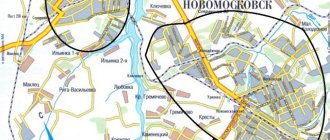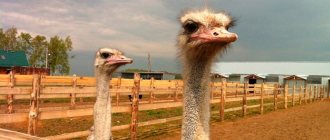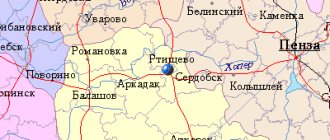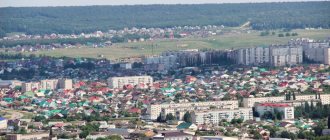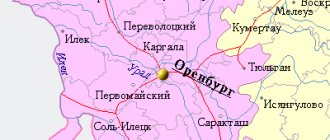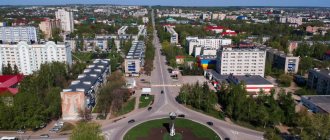Orekhovo-Zuevo is a city of regional subordination, located in the Moscow region. It is located on the Klyazma River, at a distance of 95 km from Moscow and is part of the municipal formation of Orekhovo-Zuevsky urban district, which corresponds to an administrative-territorial unit. The city is also the center of the Orekhovo-Zuevskaya agglomeration. The approximate population is 118 thousand people. The total area of the city is 36 square kilometers. In 1970, Orekhovo-Zuevo received the Order of the October Revolution. The height of the central part of the city is 120 m above sea level.
The climate in Orekhovo-Zuevo is cold and temperate, characterized by high rainfall. The annual precipitation rate is 614 mm. Warm summer begins in July. Winter also comes a little late. The city is located near peat bogs. For this reason, every autumn there is strong smog in Orekhovo-Zuevo.
Orekhovo-Zuevo is located in the same time zone as Moscow, the offset relative to Coordinated Universal Time (UTC) is +3.
Orekhovo-Zuevo Airport
The city of Orekhovo-Zuevo does not have its own airport. The nearest operating airfield is Domodedovo, which is located in Moscow. The distance from Orekhovo-Zuevo to the airport is 95 km. Domodedovo is one of the main airports in Moscow and the Moscow region and is the second in passenger traffic in the Russian Federation. It works every day around the clock. It is one of the 20 busiest airports in Europe.
Domodedovo serves aircraft of Russian and foreign airlines: Azerbaijan Airlines, Air Moldova, EgyptAir, LOT Polish Airlines, Aeroflot, Lufthansa, NordStar Airlines, S7 Airlines. Popular destinations for regular and charter flights: Istanbul, Munich, Madrid, Yekaterinburg, Paris. The airport's annual passenger traffic is more than 29 million people.
Sculptural landmarks
Orekhovo-Zuevo is famous for its large number of monuments. Although the city is considered still young, there is a lot to see in it. The sculptural sights of Orekhovo-Zuevo always attract tourists:
- Monument to A.S. Pushkin. This attraction appeared in the city in 1957 on the square named after the great Russian poet. The sculpture was erected in honor of the 120th anniversary of the memory of Alexander Sergeevich. The poet has very warm memories associated with Orekhovo-Zuevo. It was here that the work “My Genealogy” was born.
- Monument to the fighters of the revolution. In 1923, this landmark was erected in the courtyard of the Strike. Throughout its history, the monument has been “changed” into a new look three times.
- In the 80s, a monument was erected on Oktyabrskaya Square in the city in honor of the Morozov strike of 1885. This interesting monument is an interesting bronze composition of several figures.
Train Station
The Orekhovo-Zuevo railway station is a junction station of the Gorky direction of the Big Ring of the Moscow Railway. It is sorting based on the main nature of the work. The scope of work refers to an extracurricular station. The railway station is located in the Likino-Dulevo urban district at the address: st. Vokzalnaya, 19. The station is open every day around the clock.
Suburban trains to Moscow, Vladimir and the stations Krutoe, Petushki, and Zheleznodorozhnaya pass through the railway station.
Historical reference
On April 1, 2022, the Law of the Moscow Region “On the unification of the territories of the Likino-Dulevo urban district of the Moscow region and the Orekhovo-Zuevo urban district of the Moscow region” came into force.
The administrative center of the new Orekhovo-Zuyevo urban district became the city of Orekhovo-Zuevo.
The city of Orekhovo-Zuevo is one of the largest cities in the Eastern Moscow region with a multifunctional and developed infrastructure.
The history of the city is inextricably linked with the dynasties of outstanding Russian industrialists, philanthropists, the Morozovs and Zimins. In 1820, Savva Vasilyevich Morozov bought his freedom from serfdom along with his sons, acquired a plot of land on the right bank of the Klyazma and moved his production from Zuev. A commodity finishing and dyeing factory was built here. Thus began the growth of the industrial town of Nikolskoye. Subsequently, Morozov built several more factories, among them the largest paper spinning and weaving factory at that time, which employed English specialists. In 1847, the Morozovs began producing cotton fabrics. It was this period that marked the beginning of the emergence of the Orekhovsky Cotton Mill. The father's work was continued by his sons. Seventy years later, there were 17 factories in Orekhov, employing more than thirty thousand workers. At the beginning of the 20th century, the town of Nikolskoye turned into a cultural center. In the shortest possible time, barracks for workers were built, and the People's Celebration Park, which was considered the best in the Moscow province, was landscaped. A hospital with 300 beds with surgical, therapeutic, gynecological and maternity departments, an outpatient clinic and a pharmacy appeared. The Winter Theater became the first public drama theater in Russia, specially built for workers. Not a single provincial city had such a theater, the scenery of which was considered the richest and most beautiful. Orekhovo-Zuevo also went down in the history of the country as the center of the revolutionary labor movement. Here in 1885 the famous Morozov strike took place, in which more than 10,000 workers took part.
In turn, the territory of the former urban district of Likino-Dulevo is an ancient land with its own culture and interesting history, dating back many centuries. The first mention dates back to the 7th-8th centuries. In the 17th century, the territory of the southwestern part of the region - Guslitsa - was actively populated by Old Believers. The region was considered a historical, commercial and religious center. In the village of Guslitsy, handwritten books were written, mostly songs, decorated with gold ornaments. The area was also famous for its icons of local writing and copper casting.
The geographical location of the region and its historical past determined the main trends in its development. During the Soviet period, the area developed as a large industrial center. During these years, the Dulevo Paint Factory and the Likino Bus Factory were created, and enterprises created before the revolution, for example, the famous Dulevo Porcelain Factory, were improved.
Automobile highways
The following roads pass through Orekhovo-Zuevo:
- M7 "Volga" is a highway that has the status of an object of federal significance. The total length of the route is 1351 km. It is part of two European routes E22 and E017. It passes through the territory of Chuvashia, the Moscow region, the Vladimir region, Tatarstan, Bashkortostan, and the Nizhny Novgorod region. The road surface of the route is asphalt.
- A108 is a federal highway “Moscow Big Ring” with a total length of about 560 km. The route passes through the territory of three regions of Russia: Moscow, Vladimir, Kaluga. The road surface of route A108 is asphalt concrete.
- E22 is a European route that passes through the cities of the Netherlands, Great Britain, Sweden, Latvia, Russia, and Germany. The length of the highway is 5,320 km.
City parks
These sights of Orekhovo-Zuevo, Moscow region, were in an abandoned state until 2011. But now they are a place of rest for citizens and tourists:
- City park of culture and recreation. Erected in the 20s of the 20th century. It remained in poor condition for a long time. And only in 2011 the park seemed to be reborn. Flowerbeds were built here, young tree seedlings were planted, and fountains were launched. Amusements were built for the children. The highlight of the park is the city mini-zoo.
- Park of the 30th anniversary of the Victory. The park was “born” in the 70s in honor of the Great Victory over Nazi Germany. For many years it was in a deplorable state. And in 2011 they finally took on it. In 2013, a beautiful fountain was erected in the park. The Walk of Fame is being restored.
- Park named after May 1. Founded at the end of the 19th century. Workers from the Morozov factory were relaxing in the park. There is a small theater there. The legendary Fyodor Ivanovich Chaliapin gave a concert on the territory of the park.
What is the city of Orekhovo-Zuevo famous for?
- In the city of Orekhovo-Zuevo there is a Museum of Local Lore, which tells visitors about the life of local peoples over many centuries. The museum building houses more than 40 thousand different exhibits: old coins, porcelain, icons, archaeological and paleontological finds. The museum was opened in 1929 and changed its name several times during its existence.
- The visiting card of the city is the monument to the Morozov strike, which was erected in honor of the 100th anniversary of the Morozov strike of 1885. The monument is made of granite and represents weavers standing back to back. The monument conveys the spirit of unity and loyalty to the motto “One for all, all for one!”
- On the territory of the city there is the Cathedral of the Nativity of the Virgin Mary, whose area is 1,240 square meters. The church is made of red brick and has a rectangular shape. The domes are made of gold. On the territory of the cathedral there is a Sunday school, a library, a sports ground, and a pond.
- In 1914, the Banner of Labor stadium was built in Orekhovo-Zuevo, which was considered the best stadium in the Russian Empire. Today, matches of the local football club “Znamya Truda” are held here. The stadium's capacity is 6 thousand people.
- In the central part of Orekhovo-Zuevo there is the Dulevo Porcelain Museum. There is a large collection of porcelain and porcelain figurines here. The museum also hosts various lessons and master classes on porcelain painting.
- The most famous street in the city is Bugrova Street, which was previously called Teatralnaya. It received its name in honor of the famous revolutionary. On Bugrova Street there are various buildings from the 19th century: a tower where a revolutionary lived; barracks.
- In 1859, the Guslitsky Spaso-Preobrazhensky Monastery was built in the city, one of the main missions of which was to oppose the division in Guslitsy. The monastery is endowed with buildings with towers and cells.
OREKHOVO-ZUEVO
OREKHOVO-ZUEVO, a city in Russia, in the eastern part of the Moscow region, the center of the Orekhovo-Zuyevo urban district. Population 118.3 thousand people. (2019). Located in the north-west of the Meshchera Lowland, on the river. Klyazma. Important railway junction; within the city limits there is a large marshalling station (on the Big Ring of the Moscow Railway).
Story
City O.-W. formed by the union of the villages of Zuevo and Orekhovo, the town of Nikolskoye. The first settlement on the site of Zuevo arose no later than the end of the 12th century. on the left bank of the river. Klyazma. It was first mentioned as Volochyok in the Moscow Chronicle of the late 15th century. when describing the attack of the Ryazan princes in 1209 on the territory of the Grand Duchy of Vladimir. Near it there was a portage on the watershed of the Klyazma and Nerskaya rivers. In 1636 it was mentioned as a village. Volochek Zuev, in the middle - 2nd half of the 17th century. – Volochyok (Zueva); later Zuevo. From the 18th century Silk weaving actively developed here; Among the local natives are the founders of the largest business families in Russia - S. G. Zimin and S. V. Morozov (from the Morozov family). From the beginning 19th century Zuevo belonged to G.V. Ryumin and his descendants. In 1869–1921, the volost center of the Bogorodsky district of the Moscow province, from the 1870s. village. In 1916 near Zuev, in the village. Dubrovka, the Karbolit plant was founded.
The churchyard on Orekhov (on the right bank of the Klyazma) was first mentioned in the scribe book of 1636/37–1642/43 of the Vladimir district, letters and measures of Prince V.P. Kropotkin (from the Kropotkin family) and clerk I. Lukin. From the middle of the 19th century. Orekhovo developed as a trading village and was part of the Kudykino volost of the Pokrovsky district of the Vladimir province. In 1898, railway traffic on the Ilyinsky Pogost – Orekhovo line was opened.
In 1823, S. V. Morozov acquired land in the Pokrovsky district of the Vladimir province (later the town of Nikolskoye), and built factories there - a commodity-finishing factory (1830), a cloth-spinning factory (1844), a weaving factory (1846), and a paper-spinning factory (1848). The Morozovs turned Nikolskoye and Zuevo into the country's largest center of textile production, built there and in the immediate vicinity a number of other enterprises that belonged to the Trading House "Savva Morozov Son and Co" (since 1873 Partnership of the Nikolskaya Manufactory "Savva Morozov Son and Co") and Partnership of Vikuly Morozov's manufactories with his sons (established in 1882). In 1861, traffic was opened along the Moscow-Vladimir railway line that passed through Nikolskoye. The Morozov strike of 1885 took place at the Morozov factories in Nikolskoye.
City O.-W. It was founded in June 1917 by a decree of the Provisional Government as a provincial town within the Bogorodsky district of the Moscow province. On October 27 (November 9), 1917, Soviet power was established. In October - November 1918, all factories were nationalized. District city of the Moscow province (1921–29), district (1929–2018) and district (1929–30) center of the Moscow region. In 1922, traffic was opened on the Kirzhach – Orekhovo railway line. In 1928 the village was included in the city. Dubrovka. In 1936, one of the world's largest peat briquette plants was opened (operating until the 1970s). In 1940, the Karbolit – Potochino railway line was built. In 1990–2010 it had the status of a historical city of Russia. City of regional subordination (1930–31, since 1939) of the Moscow region. Since 2018, the center of the Orekhovo-Zuevsky urban district.
Architecture
Orekhovo-Zuevo. Winter theater. 1904–11. Architect A. A. Galetsky. Photo by A. S. Sokolov.
The urban planning basis of the modern central part of the city developed in the 2nd half of the 19th – early 20th centuries. On the right bank of the Klyazma, in the former town of Nikolskoye (now the Krutovsko-Kirovsky microdistrict), factory buildings with reconstructed brick production buildings have been preserved. Nearby is the building of the former Nikolsky Primary School with the Church of St. Nicholas (1908; now school No. 1). The residential area (south of the Moscow-Vladimir railway line) was built up according to the social program of S. T. Morozov according to the project of architect. A. A. Galetsky; it is based on the principles of a garden city with alternating parks and residential areas (including “Englishwoman” - a microdistrict of old wooden houses of English engineers). On the street Bugrova (formerly Teatralnaya), connecting the residential area with factories, there are monumental buildings in the Art Nouveau style: a hospital complex with a 2-story medical building, houses for doctors and paramedics, a utility building (all 1903–04) and a chapel (1905; now the Church of St. Ksenia of St. Petersburg), Winter Theater (1904–11, all - architect Galetsky; now the Cultural and Leisure Center), a 4-story building of workers' barracks for Morozov factories, connected by a passage to the rear utility block (1908). On the eastern outskirts, the building of a factory almshouse with the Church of the Apostle Timothy (1894–1901; now the faculties of natural and mathematical sciences of the Moscow State Regional Humanitarian Institute) has been preserved. From the northeast the city is adjacent to the village. Voinovo Gora with the Assumption Church in the classicist style (1835–38). At the beginning of the 21st century. The Cathedral Mosque (2000) and the Church of the Holy New Martyrs of Orekhovo-Zuevsky (2009) were built near the railway station.
On the left bank of the Klyazma from the 2nd half of the 19th century. dominated by two textile factories of the Zimin merchants, the ensemble of one of which (in the former Podgornaya manor) features a tall asymmetrical spinning building with corner towers (1907, presumably by architect V.D. Adamovich); near it is the Church of the Exaltation of the Holy Cross (1885–92). Also preserved are the 5-domed Cathedral of the Nativity of the Virgin Mary in the Russian style (1872–95, architect N.I. Finisov; the western part was expanded simultaneously with the construction of the bell tower in 1907–12, architect N.D. Strukov), the Church of the Nativity of the Virgin Mary of the Old Believer community Pomeranian Marriage Consent (eastern part - former prayer house, 1884; western vestibule with chapels and bell tower in neo-Russian style - 1911–12, architect I. E. Bondarenko). Since the late 1970s. on the banks of the Klyazma, on Oktyabrskaya Square, a new city center with public and administrative buildings was built (administration building, 1980).
Monuments: “Fighters of the Revolution” (1923; reconstructed in 1970), V.V. Mayakovsky (1953, sculptor N.P. Pustygin), M. Gorky (1954, Pustygin), S.M. Kirov (1955, N.V. . Tomsky), A. S. Pushkin (1957, Pustygin), “In memory of those who fell in the Great Patriotic War of 1941–45” (1975), participants in the Morozov strike of 1885 (1985, sculptor O. S. Kiryukhin, architects V. A. Nesterov , I. B. Kuznetsov, Yu. S. Sharov).
Centers of science and culture
State University of Humanities and Technology (founded in 1940 as a teachers' institute, current name since 2015), a branch of the Institute of Economics and Entrepreneurship. Museum of History and Local Lore (1929). Historical and local history society "Radunitsa" (1997). City Exhibition Hall.
Sport
The Znamya Truda football club is considered the oldest among those operating in the country: it was founded in 1909 as the Orekhovo Sports Club (Moscow champion in 1910–13). Under the modern name - from 1958 to 1991 and from 2003. Finalist of the USSR Cup 1962. Plays in the “West” zone of the PFL (Professional Football League) championship, at the stadium of the same name, also considered the oldest existing (opened in 1914; capacity before reconstruction 2019 –20 – about 6 thousand spectators).
Farm
Production of synthetic resins and plastics (enterprises of the Metafrax group of companies, including the Karbolit plant), paints and varnishes and powder coatings (Russian-Dutch enterprise Akzo Nobel Lakokraska), products for the needs of the defense industry (research and production enterprises "Pnevmopribor", "Respirator" and KAMPO - both produce oxygen-breathing equipment), equipment for the glass industry, translucent structures and double-glazed windows, including for transport (Steklomash company), decorated glass containers for perfumery, cosmetics and food industries (Glass Decor company plant), electrical installations, lighting products, etc. The production of textile products has remained important: fabrics, blankets, fur products (group enterprises), as well as mattresses and bedding (“Sewing products”) and etc. Near the city there are large industrial enterprises: Demikhovsky Machine-Building Plant (Demikhovsky village; a leading Russian enterprise for the development and serial production of passenger electric trains, part of the Transmashholding company).
Other routing methods
Perhaps the simplest alternative is to open a road atlas and plot a route on the map by eye. Then, by rolling a curvimeter along the route, you can get the approximate mileage. Estimating travel time will be more difficult: to do this, you will have to divide the route into fragments with the same class of roads and measure the sum of the lengths of the fragments of each class. Further, knowing the average speed for each class of roads, it is easy to calculate the time by dividing the distance by the speed.
If you don’t have a curvimeter at hand, you can use a ruler. Place the zero mark of the ruler at the starting point of the route and move the ruler, tightly adjoining it to the curves of the road.
You can also calculate the distance between cities using tables that are published in atlases and reference books. This is quite convenient for routes starting and ending in large cities. Small settlements, as a rule, are not included in the tables.
Recreation and entertainment
Like most other large cities in the Moscow region, Orekhovo-Zuevo has a well-developed leisure infrastructure, which allows you to relax comfortably, choosing entertainment for children and adults. You can go to large entertainment centers, including Atlant, CrazyVR, Loft shisha, Respirator, or small cozy cafes and restaurants, where it’s nice to spend a relaxing evening in a comfortable atmosphere. On weekends, you can go to the local park, which is always full of townspeople. There are attractions and entertainment for the youngest children and teenagers.
The best nightclubs in the city:
- Moscow Empire.
- Paradise.
- Hypnotic.
- Ibiza.
- SERDCE.
You can also find various quests that will be of interest to both teenagers and adults. New establishments are constantly opening in the city, including cafes, restaurants and all kinds of children's rooms. There is a center for musical arts and artistic sciences. Of the nightclubs, the most popular are April, 99 and Katana. Entertainment in Orekhovo-Zuevo today can be found to suit every taste and budget.
City `s history
In 1907, a decision was made to merge the two small villages of Zuevo and Orekhova, and 10 years later the village of Nikolskoye became part of the urban formation. At the same time, the city's coat of arms and flag were approved. Already at the beginning of the 20th century, the population of this city was about 50 thousand people. In the twenties and thirties of the last century, numerous industrial enterprises were created here, a railway station with the largest distillation hub in the Moscow region was opened.
It is known that the village of Zuevo was founded in the thirteenth century. This small village was located near Moscow and was known as a center of silk weaving, supplying its products to the capital's best manufactories and various artels. In the 18th and 19th centuries, the population of Zuevo was about 500 people, most of whom worked in numerous weaving factories.
At the end of the 19th century, Zuevo was a small town with a population of about 2,000 people; the largest Bogorodsky and Glukhovsky manufactories operated here. There were 15 factories in the village, which produced almost half of all weaving products in the Moscow region. At the beginning of the 20th century, in parallel with the development of Moscow, the population of the village of Zuevo began to increase rapidly, after which the need arose to unite nearby villages into one urban entity.
The exact date of the establishment of the village of Orekhovo is unknown today. Immediately after the opening of the Morozov factories in the Moscow region, peasants began to settle near them and get jobs in weaving factories. Orekhovo was also home to a large number of merchants who rented local warehouses, transporting goods to the capital and other regions of Russia. The population of this village grew rapidly; if in 1897 there were 7,200 people living here, then in 1914 there were 21.5 thousand inhabitants.
Modern life
Today the population of Orekhovo-Zuevo is 120,000 people. This city received the status of regional subordination in 2022, being the administrative center of the Zuevsky district. The area of this municipality has been significantly expanded and amounts to 508 square kilometers.
In recent years, this city has been actively developing, not only new modern industrial enterprises are opening here, but also numerous residential areas are being built, the residents of which work in Moscow. Over the past 15 years, dozens of business centers have been opened, as well as shopping complexes Nikolsky, Oreh, Kapitol, English Passage and other large hypermarkets. There is also a Pervograd hospital, several clinics and other social infrastructure facilities.
This city is located at the intersection of the Gorky railway lines of the Trans-Siberian Railway and the Great Moscow Ring. Suburban electric trains run to the capital; the average travel time to Kursky Station is 1 hour 25 minutes on an express train, while regular trains take 1 hour 45 minutes. Also at the railway station, the high-speed train Lastochka stops on the route Nizhny Novgorod - Moscow, which allows you to get to the capital in less than an hour.
